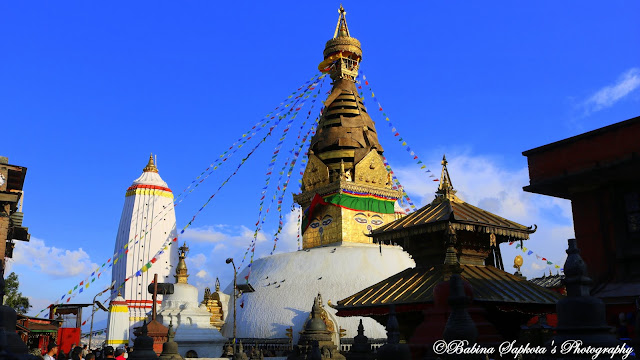Hanuman Dhoka Durbar Square
Hanuman Dhoka is a complex of structures with the Royal
Palace of the Malla kings and also of the Shah dynasty in the Durbar Square of
central Kathmandu, Nepal. It is spread over five acres. The Hanuman Dhoka
Palace (Hanuman Dhoka Darbar in Nepali) gets its name from the stone image of
Hanuman, the Hindu deity, that sits near the main entryway. 'Dhoka' means door
or gate in Nepali. The buildings were severely damaged in the 2015 earthquake.
 |
| Kal Bhairav |
 |
| House or Palace off Kumari of Kathmandu Valley |
 |
| Swet bhairav |
Inside the wooden latticed
screen, below Degu Taleju is hidden the terrifying face of Swet Bhairav. The
giant sculpture was fashioned and installed in 1795, during the rule of Rana
Bahadur Shah, the grandson of Prithvi Narayan Shah.
The screen is opened to reveal
Swet Bhairav only during the week of Indra Jatra festival in September. During
Indra Jatra nights, Swet Bhairav is alive with much festivity as local beer
pours out from the mouth through a spout and the crowd of men compete to drink
the holy beer. On other days, you can peek through the latticed window, to get
a glimpse of Swet Bhairav
 |
| Flag Seller |
 |
| Jewels Market around Basantapur Dabali |
 |
| Basantapur area along with Hanuman Dhoka or Main Gate of Palace. |
The "Hanuman Dhoka" proper, or Hanuman Gate, is
located on the west side of Durbar Square. It is the entry gate to the palace,
where a standing statue of Hanuman (monkey god), dated to 1672, guards the
palace. Hanuman is decked with a red cloth and an umbrella. The face is smeared
with a red paste. On the left is a stone sculpture dated to 1673 of Lord
Narasimha (the half-man, half lion incarnation of Lord Vishnu), devouring the
demon Hiranyakashipu, which is credited to Pratap Malla period according to an inscription
on the pedestal of the image.
 |
| Gaddhi Baithak |
The white neoclassical building shown in picture is known as the Gaddhi Baithak
stretches in the Basantapur palace area. This European style building was built
as a part of the palace in the early twentieth century by Rana prime minister
Chandra Shamsher during the reign of King Prithvi Bir Bikram Shah.
The building is known to have been modeled after London’s
National Gallery. With its white exterior and a completely European design, the
Gaddhi Baithak presents a stark contrast to the surrounding Nepali architecture.
Although Chandra Shamsher had the palace built for
residential use by Kings, by the time of King Mahendra Shah, the palace had
become a center from which Kings ruled and settled the affairs of the country,
and hence its name Gaddhi Baithak or the Royal Seat.
This modern building was partly destroyed by the Earthquake
of 2015. The present structure is reconstructed recently by Nepal Government.



Comments
Post a Comment